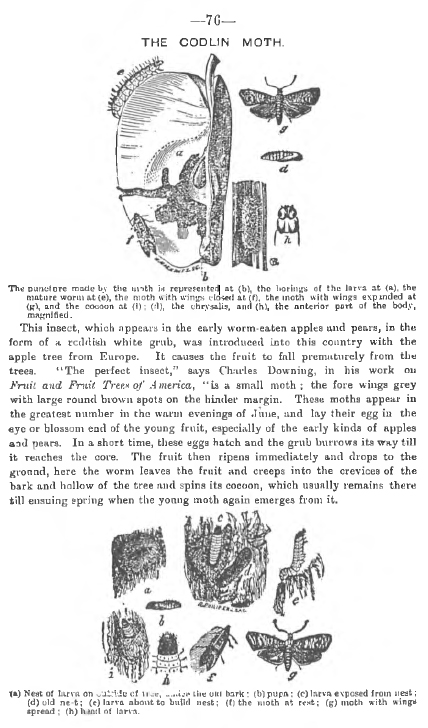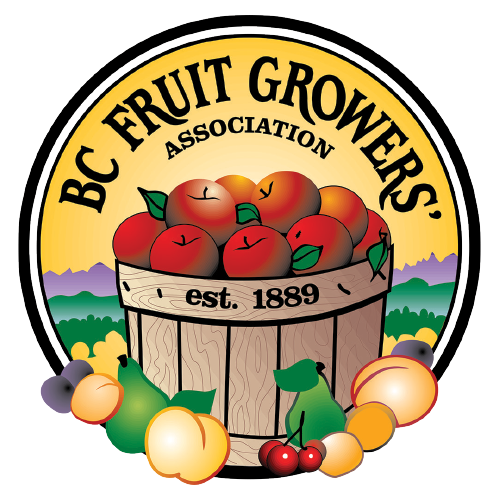1890s
The British Columbia Fruit Growers’ Association continued during the 1890s as it had begun — as a forum to exchange information among horticulturists and as a collective voice for them. The Association’s most valuable internal activity was publication of an illustrated “Pest and Remedy Supplement” which was affixed to the Annual Report beginning in 1892. This Supplement informed growers of the nature and behavior of fruit pests and diseases, and of measures which could be taken against them. This ancestor of the current Tree Fruit Production Guide for the first time gave the B.C. grower reliable information on which to operate. Starting in 1891 the B.C.F.G.A. also issued a list of varieties of fruit recommended for growing in British Columbia.
The range of interests of the Association in the 1890s was not as limited as it is today; few, if any, of the members were primarily commercial fruit growers. They were interested in vegetables and ornamentals as well-from 1891 to 1895 the organization called itself “The Horticultural Society and Fruit Growers’ Association of British Columbia” and heard papers not only on the topic of fruit growing but also on such matters as “Bee Culture”, “Bulb Culture”, “Native Flowering Shrubs”, “Hop Culture”, and “Lawns and Their Management”.
The members of the B.C.F.G.A. in the 1890s were generally farmers who had some fruit on their farms along with livestock, vegetables, and grain. Their orchards were not planted on a modern commercial scale: in 1891, the Chilliwack area, which had six members, including three directors, boasted only 51 acres of orchard. All but nine acres had been planted in that or the previous season. The B.C.F.G.A. was the major, and at first the only, province-wide organization of farmers, and its meetings often discussed matters that were sometimes far removed from fruit growing. The 1895 annual meeting called upon the provincial government to provide seed grain to the farmers of the Fraser River who had lost their crops the previous year because the great flood of 1894 prevented planting in time for the grain to ripen. In 1894, the Association considered a motion:
That, whereas, the common practice of feeding salmon to hogs by farmers along the Fraser River and tributaries has an injurious effect on the meat and renders it unfit for use, particularly in the packing business, which, shortly, will consume a great proportion of the hogs raised in the Province; and Whereas, packers refuse to purchase salmonfed hogs, or hogs suspected of being so fed, the industry in this district is threatened with serious damage from this practice, therefore be it Resolved, that this Association condemns in unmeasured terms the practice of feeding salmon to hogs, and recommends to all farmers in their own interests to abandon the practice, and so establish a reputation beyond suspicion, and in this way protect from disaster one of the most promising industries in agriculture.
At the same convention, E. Hutcherson drew attention to the need for a provincial dairymen’s organization; at the adjournment of the fruit growers’ meeting those present immediately reconvened to form the .C. Dairymen’s Association. 2″
With its good relationship with the provincial government, the B.C.F.G.A. also brought about the formation of two other entities which were of great value in the agricultural development of British Columbia.
Early in 1892 the Association submitted to the provincial government a draft bill to create a Board of Horticulture similar to those in Washington and Oregon. This was passed by the Legislature in April, creating a six-member provincial Board of Horticulture, which would prepare regulations “for the purpose of preventing the spread of contagious diseases among fruits and fruit trees, and for the prevention, treatment, cure and extirpation of fruit pests and the diseases of fruits and fruit trees.” An Inspector of Fruit Pests was appointed, whose duties were to inspect “orchards, nurseries and other places suspected or believed to be infested with fruit pests” and to report to the Board, which could, if the offender failed to treat the problem, impose a fine of up to one hundred dollars and order any necessary work done at the owner’s expense.2

At first there was considerable confusion about the powers of the Board of Horticulture and the Inspector of Fruit Pests. E. Hutcherson, the first Inspector, felt it necessary to explain to the 1893 B.C.F.G.A. annual meeting that “he did not have the privilege of entering any man’s orchard and destroying the pests as had been thought”; nor was it true “that he was coming round with a spraying outfit, and would charge nurserymen $5 a day.”2 All he could do was to report infected properties to the Board with recommendations for action. Such action was frustrated during the first year of operation by the fact that three of the appointees to the Board were members of the legislature and had their positions questioned because they were not supposed to hold government jobs. In addition, one other Board member had been away in England for the whole year.
Revisions to the act in 1893 solved most of the difficulties, and significantly expanded the scope of the Inspector’s duties. He was now “from time to time, under the direction of the Board, [to] hold meetings throughout the Province in the interests of horticulture, and impart such information and instruction to fruit growers and farmers as may tend to the improvement of the fruit industry of the Province.” The Board of Horticulture settled down to inspecting orchards and fruit shipments, and spreading information about fruit growing methods, especially in regard to spraying and orchard hygiene. After the turn of the century, it acted as a clearinghouse for market information for those shipping to distant markets such as the Prairies. In 1902, for example, the Inspector of Fruit Pests had burned 3500 of 65,000 imported fruit trees inspected, and condemned large quantities of imported fruit — as much as 1100 boxes in one day.
Vignette: Fruit Varieties, 1891
At the 1891 B.C.F.G.A. annual meeting a special committee was appointed to report on what varieties of fruit were best to grow for profit in British Columbia. They recommended the following varieties:
Apples
Early summer: Yellow Transparents, Red Astrachan.
Later summer: Oldenburg, Gravenstein.
Fall: Wealthy, King.
Winter: Northern Spy, Baldwin, Golden Russet, Ben Davis, Canada Red.
Sweet Apples
Summer: Golden Sweet.
Fall: Bailey’s Sweet.
Winter: Talman’s Sweet.
Crabs
Transcendent, Hyslop, Montreal Beauty.
Pears
Summer: Clapp’s Favorite, Bartlett.
Fall: Beurre, Clairgeau, Beurre D’Anjou.
Winter: Lawrence, Beurre Easter.
Plums
Peach plums, Bradshaw, Imperial Gage, Lombard, Red Egg, Yellow Egg, Reine Claude de Bavay.
Prunes
Italian, French, Pond’s Seedling, Coe’s Golden Drop.
Cherries
Sweet: Early Purple Guigne, Governor Wood, Black Tartarian, Napolean Bigarreau (Royal Ann), Yellow Spanish, Windsor.
Sour: May Duke, Large Montmorenci, English Morello.
Peaches
Alexander, Waterloo, Early Rivers, Hale’s Early, Early Crawford and Wager.
Apricots and Nectarines
Not sufficiently tested to be recommended.
Quince
Orange.
Grapes
Black: Moore’s Early, Worden, Concord.
Red: Delaware, Brighton.
White: Niagara.
Strawberries
Crescent, Wilson, Sharpless, Bubach No. 5, Improved Jocunda.
Raspberries
Marlborough, Cuthbert, Golden Queen.
Black caps
Louhegan, Tyler, Gregg.
Blackberries
Snider, Kittatiny, Erie, Taylor. English gooseberries Industry, liable to mildew in some localities.
American gooseberries
Champion, Downing. Red currants Lay’s Prolific, Moore’s Ruby, Cherry currant.
White currants
White Grape.
Black currants
Lee’s Prolific, Black Champion, Black Naples.
List of varieties not thoroughly tested but worthy of trial
Apples
Summer: Keswick, Codlin, Alexander.
Fall: Haas, Colvert, Princess Louise, Maiden’s Blush, Red Bertigheimer.
Winter: Pewaukee, McIntosh’s Red, Hubbardson’s Nonesuch, Seekno- further, Rhode Island Greening, Grimes’ Golden, Stark, Newtown Pippin, Yellow Bellflower.
Pears
Summer: Madeline, Marguerite, Brockworth Park.
Fall: Beurre Bossock, Duchess D’Angouleme, Howell, Sheldon.
Winter: Josephine de Malines.
Plums
Genii, McLaughlan, Moore’s Arctic, Jefferson, Shipper’s Pride, Smith’s Orleans.
Cherries
Rockport Bigarreau, Olivet, Mezel, Black Republican.
Peaches
Foster, Shumaker, Wheatland and Coolidges Favorite.
Grapes
Moore’s Diamond, Meyer.
Strawberries
Haverland, Warfield No. 2, Triomphe de Gand.
Apricots
Moorpark, Early Golden, St. Catherine, St. Ambrose, Early Montgamet.
Nectarines
Boston, Early Violet.
Quince
Rhea’s Mammoth, Champion.
The second entity created by the provincial government was the system of Farmers’ Institutes. G.H. Hadwen made a call at the 1897 B.C.EG.A. annual meeting for a system of local Farmers’ Institutes similar to those which had flourished in Ontario since 1885. This lead was followed up by the British Columbia government, which passed legislation later in 1897 allowing such Farmers’ Institutes to be set up and to receive a government grant in any locality where fifteen farmers petitioned for one. Response was slow, and the Deputy Minister of Agriculture, J.R. Anderson, asked the B.C.F.G.A. to assist in encouraging formation of Farmers’ Institutes. Despite the slow start, the Farmers’ Institutes did catch on. By 1914 there were over eighty of them throughout the province.







